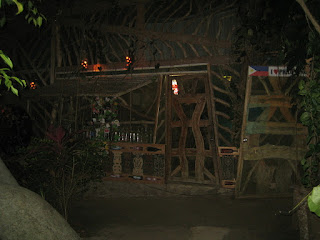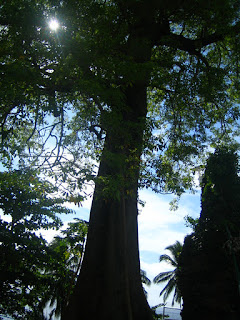Camiguin, a small province in the northern tip of Mindanao is actually an island born of fire, shaped and formed by hardened molten lava, cinders and ashes spewed by its volcanoes over centuries of repeated eruptions; of which only Mount Hibok Hibok remained active to this day. Standing majestic in the midst of Bohol Sea, Macajalar Sea, Gingoog Bay and Butuan Bay, Camiguin island had long been an elusive dream for me.
Camiguin adventure could have been my birthday gift for DeeJ last January 29, 2009 but the moment we set foot at Cagayan de Oro airport on January 28, 2009, we had to cancel our Enigmata reservation and flew back to Manila the soonest time possible because his Dad had a stroke.
 |
| Camiguin Island |
Camiguin adventure could have been my birthday gift for DeeJ last January 29, 2009 but the moment we set foot at Cagayan de Oro airport on January 28, 2009, we had to cancel our Enigmata reservation and flew back to Manila the soonest time possible because his Dad had a stroke.
Three months hence, the call to complete my previously cancelled commitment with
SelJ Pharmaceutical Company had come. With a go signal from the medical team we
had to bring along his Dad to dodge off the nightmare we experienced before. But
of course, Dane would not be left behind.
On April
23, 2009, Dannie and I went ahead to Ozamis City for a lecture discussion at MHARS.
The following day, instead of cruising along Lanao del Norte
to reach Cagayan de Oro for another commitment, we had to get a round air trip from Ozamis to Manila to
Cagayan de Oro. I could have preferred to cross the span of sea between Ozamis
and Iligan then the land route from Iligan to Cagayan de Oro where we could
have a glance at the majestic Ma. Christina Falls, but due to the bombings
in the area at that time, they would not like us to take chances.
At 6 AM on April 25, 2009, Cebu Pacific carrying DeeJ and Dane landed on Cagayan de Oro airport. At 8:30 AM we were on board Paras Sea Cat on our way to Camiguin.
At 11:30 AM the sea cat harbored at Benoni wharf in Camiguin. We chose one of the jeepneys that abound there to take us to Enigmata.
I thought our Camiguin island adventure would be more meaningful if we stay in Enigmata Treehouse Ecolodge. They were kind enough to still consider the reservation fee that we forwarded to them 3 months ago.
 |
| Enigmata Treehouse Ecolodge |
On our way up to the eagle's nest, we stepped on stairways of artistically carved woods to reach the second level; then a winding staircase brought us to the third level,
the Eagle's Nest resting amid canopy of trees.
 |
| Eagle's nest |
The artist in me was stirred by how this haven was conspicuously designed.
From the moment we entered into its gate however, Dane got a dreary feeling on the eeriness of the surrounding. It was as if we were stepping into another dimension.
It could have been brought by the spirit of the century old acacia tree that stood magnificently in the very heart of the tree house; the same spirit that could have driven Ben Achia to build this structure; the very same spirit that united the vibrant young artists to collectively express their various masterpiece in this place they call enigmata which means open your eyes.
Enigmata and the organic food served by its friendly obliging staff gave us a good start for our Camiguin sojourn.


The young American couple who hitched a ride with us described the view below as reminiscent of Hawaii.
Nonetheless, nowhere in Hawaii would you find a cemetery underneath the sea. This old cemetery in Bonbon Catarman was sunk by a volcanic holocaust in 1871. The cross marker was built in 1982.
 |
| Sunken cemetery in Bonbon Catarman Camiguin |
Sailing over a symphony of corals and variety of colorful fishes breeding among submerged century old tombstones was like cruising with the Pirates of the Caribbean in search of the Dead Man's Chest.
Also wiped out in the said 1871 volcanic eruption was the whole Spanish settlement of Catarman which was built in 1697. The ruins of the GUI-OB Church, the adobe walls,
 |
| Ruins of GUI-OB Church |
 |
| Sunken belfry of ruined GUI-OB church |
 |
| Colonade of GUI-OB church ruins |
and the convent are vestiges of the Spanish-era culture in Camiguin standing today as reminder of the havoc that nature could render instantaneously.
On our way to Sto. Nino Cold Spring we caught the splendid sight of the 1,250 slope of Mount Hibok Hibok, the only remaining active volcano here said to be lodging a crater at its peak. Mountaineers who would brave the loose rocks and boulders to reach its top would be rewarded with a breathtaking view of the islands of Negros, Bohol and Cebu.
 |
| Mt. Hibok Hibok & Tres Marias Volcanoes |
We found Sto. Nino spring in Catarman to be teeming with people so much so that we wondered if the water in the 20 meters by 40 meters pool would still be 20 degree centigrade cold and if our feet would still be visible beneath the 2 meters deep crystal clear water of this fresh water lake.
What could have been an idyllic spring would be the Macao Cold Spring in Mahinog where we could have experienced the cold splash of clear blue-green mineral water teeming with fish while being shed by a canopy of century old trees. But then we were told that its location in the middle of the forest with no real road and signage would make it a tough challenge for us to hurdle.
Anyway the Katibawasan water falls aside from being an easy climb while riding our van was a much better alternative. At its foot, we had to strain our necks to be able to have a full view of the 250 feet water falls cascading in its magnificent splendor amid the backdrop of rock faces strewn with majestic trees, ferns and orchids. We had to stay away from the rock pool where with all its might the water would fall in full force.
 |
| Katibawasan Water Falls |
Since it was already 6 PM, we accepted the fact that we could not stand being immersed in this ice cold water, so we went back to Mambajao for our dinner. A night dip at the Ardent Hot Spring had been decided for us.
Back at the Eagle's Nest which could have accommodated up to 12 people, the four of us had the leisure to choose which place to take our rest.
The high pitched humming of the crickets and the low toned croaking of the tuko (gecko) lulled all of us to deep slumber under a number of dream catchers.
We had to wake up at 4 AM so we could catch the sunrise in White Island. Dane's decision supervened our desire to stay longer in Eagle's Nest. He would like to behold the famous Camiguin stars as they flicker against the shadows of Mambajao beach so we had to transfer to a beach house in Agohay. A decision that even Dane regretted for we never saw the sunrise, neither the sunset nor the twinkling stars over Mambajao beach. We terribly missed the reasonably priced organic food of Enigmata and the chance to mingle with nature at night while comfortably lodged in the open attic where we could have actually touched the top most leaves of the surrounding trees and seen the fireflies eye to eye.
The boatman asked us what time he was going to fetch us from the White Island and we marked the time at 9AM but while steering away from us, we shouted 8 AM, for the sight of a C shaped sandbar without any vegetation made us think that 3 and a half hours would be too long to explore it.
 |
| White Island, Camiguin |
 |
| Mount Hibok Hibok view from White Island |
We never had a glimpse of the glorious sunrise since the dark clouds in the horizon settled over the island to give a rain shower. The moment the clouds cleared, the sun was already glaring on the sky.
It was then that we realized that we should have followed Rosalie's advice to go to Mantigue island this day then to White Island on the early morning of our last stay in Camiguin before we embark home at 11AM.
DeeJ dreamed of his Mica Mazda 6 gliding along the well paved coastal road of Camiguin like a swan on a lake.
Out of this reverie, he would not give in to a dive to see the giant oysters in Cambuhat Oyster Farm at Kabila White beach. Dane did it alone.
 |
| Kabila White Beach/ Cambuhat Oyster Farm |
At Languines lagoon, little did we know that the big crab that amused us would land on our plates. Despite the dismay, we found its meat deliriously delicious.
I was amazed at how an ancient looking jeepney managed to bring us to Mt. Hibok Hibok Volcano Observatory through the 2.5 kilometer steep concrete road climb. The accommodating staff allowed us to read the historical and scientific poster exhibit, entertained our queries and offered information.
Four overlapping stratovolvanoes lay seated on older buried edifices of Camiguin. Mount Mamburao at 1,552 meters is the highest but is inactive with no recorded eruptions yet. Mount Butay and Mount Guinsiliban are eroded stratovolcanoes with vents cutting accross the whole island. The Binoni cinder cone is along the southeast coast. Hibok Hibok also known as Catarman is the youngest yet the only historically active one with domes at Mount Vulcan or Old Volcano which had been attributed for major eruptions during 1871-75 and 1948-53 that devastated the coastal villages.
Disappointed that we were not able to include Mantigue island to our itinerary, we lost our enthusiasm in climbing the Camiguin Walkway to Mount Vulcan and the Stations of the Cross in Bonbon Catarman. The one hour hike through concrete stairs could have allowed us to have a view of Camiguin island at the top. Well anyway we did have that in PHILVOCS Observatory.
We did not forget however to visit Camiguin's church.
On board a Ro Ro ferry that would bring us to Balingoan Port in Misamis Oriental, the four hectare evergreen forest and fringe beaches of Mantigue island seemed to be inviting us to come back.
Likewise, the undulating hills of the seven volcanoes were not bidding us farewell but so long.
 |
| Camiguin, the island of 7 volcanoes |
Our tour guide was all praises for their elected officials particularly the governor and the congressman. Undoubtedly, these two had a lot of political will not to give in to the lure of Jollibee and McDo et al. They would not like plastics and styrofoam add up to the pyroclastic litters emitted by their volcano. They would not allow these big establishments rob their local businessmen of consumers and source of income. Locals here are happily coexisting with their natural resources. They do not fish within the designated protected area; they take care of their environment. No wonder Camiguin is listed as one of the best dive sites in the world.
You may also like













































for cheapest camiguin tours and accommodations pls visit: www.camiguintransport.blogspot.com
ReplyDeletealternate website: www.pabualancottages-camiguin.blogspot.com
ReplyDelete